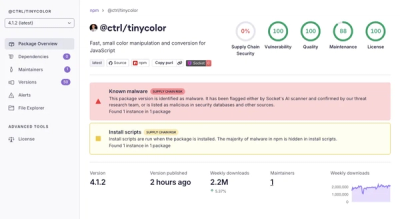
Research
/Security News
Popular Tinycolor npm Package Compromised in Supply Chain Attack Affecting 40+ Packages
Malicious update to @ctrl/tinycolor on npm is part of a supply-chain attack hitting 40+ packages across maintainers
cloudevents
Advanced tools
The 'cloudevents' npm package is a library for working with CloudEvents, which are a specification for describing event data in a common way. This package allows you to create, validate, and serialize/deserialize CloudEvents, making it easier to work with event-driven architectures.
Create CloudEvent
This feature allows you to create a new CloudEvent instance with specified attributes such as type, source, and data.
const { CloudEvent } = require('cloudevents');
const myEvent = new CloudEvent({
type: 'com.example.someevent',
source: '/mycontext',
data: {
foo: 'bar'
}
});
console.log(myEvent);Validate CloudEvent
This feature allows you to validate a CloudEvent instance to ensure it conforms to the CloudEvents specification.
const { CloudEvent, ValidationError } = require('cloudevents');
const myEvent = new CloudEvent({
type: 'com.example.someevent',
source: '/mycontext',
data: {
foo: 'bar'
}
});
try {
myEvent.validate();
console.log('Event is valid');
} catch (e) {
if (e instanceof ValidationError) {
console.error('Event is invalid:', e.errors);
}
}Serialize CloudEvent
This feature allows you to serialize a CloudEvent instance to a JSON string, which can be useful for transmitting the event over a network.
const { CloudEvent } = require('cloudevents');
const myEvent = new CloudEvent({
type: 'com.example.someevent',
source: '/mycontext',
data: {
foo: 'bar'
}
});
const serializedEvent = myEvent.toString();
console.log(serializedEvent);Deserialize CloudEvent
This feature allows you to deserialize a JSON string back into a CloudEvent instance, making it easier to work with received events.
const { CloudEvent } = require('cloudevents');
const serializedEvent = '{"type":"com.example.someevent","source":"/mycontext","data":{"foo":"bar"}}';
const myEvent = CloudEvent.parse(serializedEvent);
console.log(myEvent);EventEmitter3 is a high-performance event emitter for Node.js and the browser. While it does not specifically adhere to the CloudEvents specification, it provides a robust way to handle events in an application.
Node EventStore Client is a client for EventStore, a database optimized for event sourcing. It provides more advanced features for event storage and retrieval but is more complex and specific to EventStore.
The AWS SDK for JavaScript provides a way to interact with AWS services, including event-driven services like AWS Lambda and Amazon EventBridge. It offers broader functionality but is specific to the AWS ecosystem.
The CloudEvents SDK for JavaScript.
Note: Supports CloudEvent version 1.0
The CloudEvents SDK requires a current LTS version of Node.js. At the moment those are Node.js 16.x, and Node.js 18.x. To install in your Node.js project:
npm install cloudevents
You can choose any popular web framework for port binding. A CloudEvent
object can be created by simply providing the HTTP protocol binding
the incoming headers and request body.
const app = require("express")();
const { HTTP } = require("cloudevents");
app.post("/", (req, res) => {
// body and headers come from an incoming HTTP request, e.g. express.js
const receivedEvent = HTTP.toEvent({ headers: req.headers, body: req.body });
console.log(receivedEvent);
});
The easiest way to send events is to use the built-in HTTP emitter.
const { httpTransport, emitterFor, CloudEvent } = require("cloudevents");
// Create an emitter to send events to a receiver
const emit = emitterFor(httpTransport("https://my.receiver.com/endpoint"));
// Create a new CloudEvent
const ce = new CloudEvent({ type, source, data });
// Send it to the endpoint - encoded as HTTP binary by default
emit(ce);
If you prefer to use another transport mechanism for sending events
over HTTP, you can use the HTTP binding to create a Message which
has properties for headers and body, allowing greater flexibility
and customization. For example, the axios module is used here to send
a CloudEvent.
const axios = require("axios").default;
const { HTTP, CloudEvent } = require("cloudevents");
const ce = new CloudEvent({ type, source, data });
const message = HTTP.binary(ce); // Or HTTP.structured(ce)
axios({
method: "post",
url: "...",
data: message.body,
headers: message.headers,
});
You may also use the emitterFor() function as a convenience.
const axios = require("axios").default;
const { emitterFor, Mode, CloudEvent } = require("cloudevents");
function sendWithAxios(message) {
// Do what you need with the message headers
// and body in this function, then send the
// event
axios({
method: "post",
url: "...",
data: message.body,
headers: message.headers,
});
}
const emit = emitterFor(sendWithAxios, { mode: Mode.BINARY });
emit(new CloudEvent({ type, source, data }));
You may also use the Emitter singleton to send your CloudEvents.
const { emitterFor, httpTransport, Mode, CloudEvent, Emitter } = require("cloudevents");
// Create a CloudEvent emitter function to send events to our receiver
const emit = emitterFor(httpTransport("https://example.com/receiver"));
// Use the emit() function to send a CloudEvent to its endpoint when a "cloudevent" event is emitted
// (see: https://nodejs.org/api/events.html#class-eventemitter)
Emitter.on("cloudevent", emit);
...
// In any part of the code, calling `emit()` on a `CloudEvent` instance will send the event
new CloudEvent({ type, source, data }).emit();
// You can also have several listeners to send the event to several endpoints
All created CloudEvent objects are read-only. If you need to update a property or add a new extension to an existing cloud event object, you can use the cloneWith method. This will return a new CloudEvent with any update or new properties. For example:
const {
CloudEvent,
} = require("cloudevents");
// Create a new CloudEvent
const ce = new CloudEvent({...});
// Add a new extension to an existing CloudEvent
const ce2 = ce.cloneWith({extension: "Value"});
You can create a CloudEvent object in many ways, for example, in TypeScript:
import { CloudEvent, CloudEventV1, CloudEventV1Attributes } from "cloudevents";
const ce: CloudEventV1<string> = {
specversion: "1.0",
source: "/some/source",
type: "example",
id: "1234"
};
const event = new CloudEvent(ce);
const ce2: CloudEventV1Attributes<string> = {
specversion: "1.0",
source: "/some/source",
type: "example",
};
const event2 = new CloudEvent(ce2);
const event3 = new CloudEvent({
source: "/some/source",
type: "example",
});
When parsing JSON data, if a JSON field value is a number, and that number
is really big, JavaScript loses precision. For example, the Twitter API exposes
the Tweet ID. This is a large number that exceeds the integer space of Number.
In order to address this situation, you can set the environment variable
CE_USE_BIG_INT to the string value "true" to enable the use of the
json-bigint package. This
package is not used by default due to the resulting slowdown in parse speed
by a factor of 7x.
See for more information: https://github.com/cloudevents/sdk-javascript/issues/489
There are a few trivial example applications in the examples folder. There you will find Express.js, TypeScript and Websocket examples.
| Core Specification | v0.3 | v1.0 |
|---|---|---|
| CloudEvents Core | :white_check_mark: | :white_check_mark: |
| Event Formats | v0.3 | v1.0 |
|---|---|---|
| AVRO Event Format | :x: | :x: |
| JSON Event Format | :white_check_mark: | :white_check_mark: |
| Protocol Bindings | v0.3 | v1.0 |
|---|---|---|
| AMQP Protocol Binding | :x: | :x: |
| HTTP Protocol Binding | :white_check_mark: | :white_check_mark: |
| Kafka Protocol Binding | :x: | :white_check_mark: |
| MQTT Protocol Binding | :white_check_mark: | :x: |
| NATS Protocol Binding | :x: | :x: |
| Content Modes | v0.3 | v1.0 |
|---|---|---|
| HTTP Binary | :white_check_mark: | :white_check_mark: |
| HTTP Structured | :white_check_mark: | :white_check_mark: |
| HTTP Batch | :white_check_mark: | :white_check_mark: |
| Kafka Binary | :white_check_mark: | :white_check_mark: |
| Kafka Structured | :white_check_mark: | :white_check_mark: |
| Kafka Batch | :white_check_mark: | :white_check_mark: |
| MQTT Binary | :white_check_mark: | :white_check_mark: |
| MQTT Structured | :white_check_mark: | :white_check_mark: |
Currently active maintainers who may be found in the CNCF Slack.
We love contributions from the community! Please check the Contributor's Guide for information on how to get involved.
Each SDK may have its own unique processes, tooling and guidelines, common
governance related material can be found in the
CloudEvents community
directory. In particular, in there you will find information concerning
how SDK projects are
managed,
guidelines
for how PR reviews and approval, and our
Code of Conduct
information.
If there is a security concern with one of the CloudEvents specifications, or with one of the project's SDKs, please send an email to cncf-cloudevents-security@lists.cncf.io.
FAQs
CloudEvents SDK for JavaScript
The npm package cloudevents receives a total of 995,078 weekly downloads. As such, cloudevents popularity was classified as popular.
We found that cloudevents demonstrated a healthy version release cadence and project activity because the last version was released less than a year ago. It has 3 open source maintainers collaborating on the project.
Did you know?

Socket for GitHub automatically highlights issues in each pull request and monitors the health of all your open source dependencies. Discover the contents of your packages and block harmful activity before you install or update your dependencies.

Research
/Security News
Malicious update to @ctrl/tinycolor on npm is part of a supply-chain attack hitting 40+ packages across maintainers

Security News
pnpm's new minimumReleaseAge setting delays package updates to prevent supply chain attacks, with other tools like Taze and NCU following suit.

Security News
The Rust Security Response WG is warning of phishing emails from rustfoundation.dev targeting crates.io users.